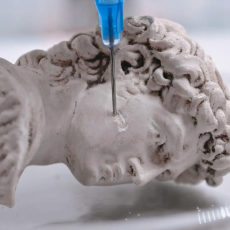
Nanoscale 3D printing material can be used to protect microelectronics, while this highly conductive metallic gel, developed by researchers at NC State University, is capable of 3D printing solid objects at room temperature. The metallic gel starts out as a solution of micron-scale copper particles suspended in water before the a small amount of an indium-gallium alloy, a liquid metal at room temperature, is added.
The micro-scale copper particle and indium-gallium alloy mixture is then stirred together, which causes the liquid metal and copper particles to stick to each other, resulting in a metallic gel “network” within the aqueous solution. This gel can then be used by a conventional 3D printing nozzle and still retain its shape when printed, enabling users to create complex shapes like what you see here. When it is allowed to dry at room temperature, the 3D object becomes even more solid and retains its shape.
- One-Click Automatic Printing: Experience hassle-free 3D printing with the Adventurer 5M Series. Enjoy automatic bed leveling for flawless first...
- 12X Ultra Fast Printing: Featuring a CoreXY structure with 600mm/s travel speed and 20000mm/s² acceleration, the AD5M maximizes efficiency, reduces...
- Smart and Efficient Design: Quick 3-second nozzle changes, a high-flow 32mm³/s nozzle, and fast 35-second warm-up to 200°C deliver stable high-speed...

This gel-like consistency is important, because it means you have a fairly uniform distribution of copper particles throughout the material This does two things. First, it means the network of particles connect to form electrical pathways. And second, it means that the copper particles aren’t settling out of solution and clogging the printer. Ultimately, this sort of four-dimensional printing – the traditional three dimensions, plus time – is one more tool that can be used to create structures with the desired dimensions,” said Michael Dickey, Camille & Henry Dreyfus Professor of Chemical and Biomolecular Engineering at North Carolina State University.






